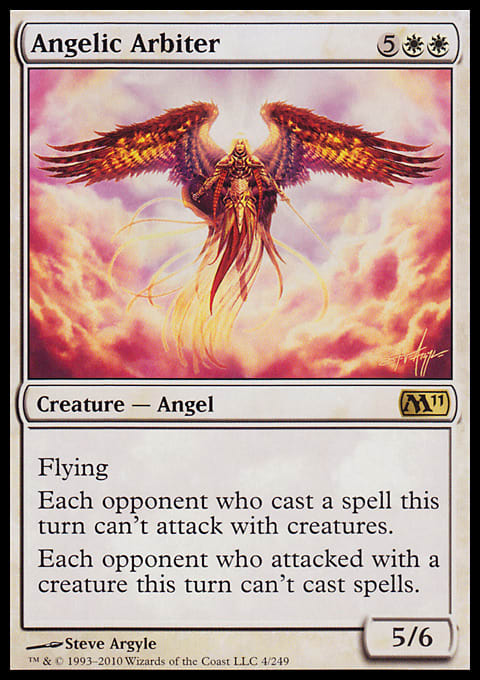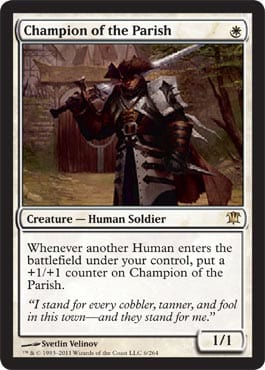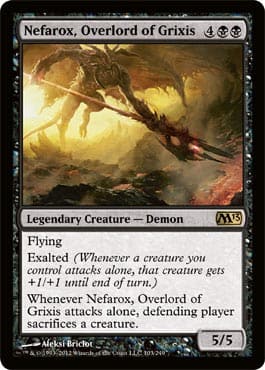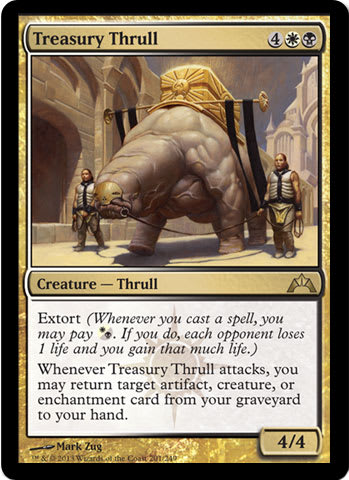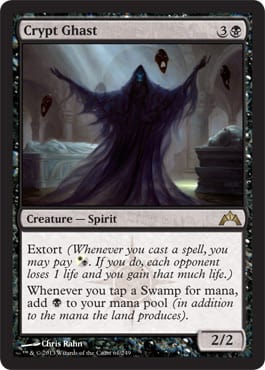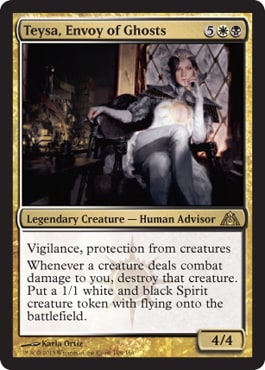Last week, we took a walk through history through a decidedly Black and White lens, looking at the evolution of Orzhov decks as manifested in Theme Decks. Next, we’re turning toward the B/W Intro Packs. As we’ll see, there was a curious pattern to the use of Black and White in the Preconstructed decks.
Many sets avoided it altogether, but those that embraced it really embraced it. Entire blocks came and went without any Orzhov-component entries, while others put it in every set. Core Sets, similarly, fell into a pattern, with the Intro Packs from even years having none, but every Core Set on an odd year containing one. The vagaries of chance . . . or something more sinister?
Year: 2010
Set: Magic 2011
Deck: Blades of Victory
Rares: Angelic Arbiter, Vengeful Archon
Blades of Victory ? Intro Pack | Wizards of the Coast
- Creatures (19)
- 1 Angelic Arbiter
- 1 Silvercoat Lion
- 1 Vengeful Archon
- 1 War Priest of Thune
- 1 White Knight
- 2 Ajani's Pridemate
- 2 Cloud Crusader
- 2 Elite Vanguard
- 2 Infantry Veteran
- 2 Palace Guard
- 2 Serra Angel
- 2 Siege Mastodon
- Instants (7)
- 1 Condemn
- 1 Doom Blade
- 1 Mighty Leap
- 1 Safe Passage
- 1 Stabbing Pain
- 2 Inspired Charge
- Sorceries (3)
- 1 Assassinate
- 1 Duress
- 1 Mind Rot
- Enchantments (5)
- 1 Ajani's Mantra
- 2 Armored Ascension
- 2 Pacifism
- Artifacts (1)
- 1 Warlord's Axe
All of Shards of Alara and Zendikar blocks had passed by before we find the first Black and White Intro Pack, here in the Magic 2011 Core Set. Still, Blades of Victory makes for a fairly solid debut. In our past histories, we’ve broadly grouped decks into one of two camps. The first camp is a deck that does ordinary things that any color can do, like attacking with creatures and casting spells, but does them with their colorful flavor. The other camp are those decks that are truly unique, in that they do only something that the color combination is capable of. While the latter have tended to be the more interesting decks, that doesn’t necessarily discount the former from being interesting.
Case in point is Blades of Victory. Sure, it’s got all the things you’d expect from an “ordinary” B/W deck, with cards like Elite Vanguard, White Knight, and Serra Angel. A horde of White creatures with Black removal to back them up doesn’t break a lot of new ground. But a closer look reveals a rather interesting twist: lifegain.
While Magic has always had ways to gain life, just as “spells matter” has come to define the colors of Red and Blue, so has the relevance of lifegaining grown into something identifiable with White and (to a lesser degree) Black. You see that here in the two-card tandem of Ajani's Pridemate and Ajani's Mantra. It’s a simple combo: gain life each turn, and watch the Pridemates grow and grow and grow.
It's not pushed — you only get two copies of the Pridemate and a singleton Mantra, and there aren’t any other sources of lifegain in the deck. But it was an interesting note that would highlight the increasing attention paid to gaining life and life totals.
Year: 2012
Set: Dark Ascension
Deck: Dark Sacrifice
Rares: Champion of the Parish, Fiend of the Shadows
Dark Sacrifice ? Intro Pack| Wizards of the Coast
- Creatures (22)
- 1 Champion of the Parish
- 1 Disciple of Griselbrand
- 1 Fiend of the Shadows
- 1 Mausoleum Guard
- 1 Selfless Cathar
- 1 Skirsdag Flayer
- 1 Wakedancer
- 2 Doomed Traveler
- 2 Elder Cathar
- 2 Elgaud Inquisitor
- 2 Unruly Mob
- 2 Village Cannibals
- 3 Falkenrath Torturer
- 2 Galvanic Juggernaut
- Instants (3)
- 1 Gravepurge
- 2 Altar's Reap
- Sorceries (9)
- 1 Lingering Souls
- 1 Unburial Rites
- 2 Death's Caress
- 2 Night Terrors
- 3 Gather the Townsfolk
- Artifacts (2)
- 1 Avacyn's Collar
- 1 Demonmail Hauberk
- Lands (24)
- 11 Swamp
- 12 Plains
- 1 Haunted Fengraf
One of the greatest Theme Decks of all time was found in Mirrodin, with the ridiculously-named Sacrificial Bam. Cast a lot of artifacts, then feed them to your creatures while a Disciple of the Vault looks on approvingly, the deck came together wonderfully and was a self-destructive delight.
Dark Sacrifice takes a page out of that same playbook, to good effect. In a deck nearly all-Human, you deploy a load of creatures, then get to sacrifice them to various outlets for whatever effect is needed in the moment. Some of your creatures offer you lifegain (Disciple of Griselbrand), others (Skirsdag Flayer) can dispatch your opponent’s creatures, still more convey buffs and bonuses (Falkenrath Torturer).
And that’s just the beginning of the synergies and interplays at work here, since other cards benefit from all the dying going on on your side of the table. Cards like Galvanic Juggernaut, Wakedancer, Village Cannibals, and Unruly Mob all give you added incentive for putting your own creatures to the knife.
This would be a fine construction if that’s all there was to it, but Dark Sacrifice doesn’t stop there. Rather, it also gives you creatures who want to be sacrificed. You’re not just getting rid of otherwise useful and contributing members of your society, but rather creatures that offer a benefit in death that they didn’t provide in life. From Doomed Traveler to Mausoleum Guard, Selfless Cathar to Elder Cathar, these cards helped offset the potential card disadvantage that comes with self-sacrifice.
And all this without mention of the Champion of the Parish, a superb rare inclusion (although somewhat less impressive as a singleton, since he wasn’t very good when drawn late). This was a frighteningly well-constructed deck, surely one in contention for any list of the best of the Intro Pack era.
Year: 2012
Set: Magic 2013
Deck: Sole Domination
Rares: Nefarox, Overlord of Grixis, Xathrid Gorgon
Sole Domination ? Intro Pack| Wizards of the Coast
- Creatures (26)
- 1 Guardians of Akrasa
- 1 Knight of Glory
- 1 Liliana's Shade
- 1 Nefarox, Overlord of Grixis
- 1 Vampire Nighthawk
- 1 Veilborn Ghoul
- 1 Warclamp Mastiff
- 1 Xathrid Gorgon
- 1 Zombie Goliath
- 2 Aven Squire
- 2 Bloodhunter Bat
- 2 Duskmantle Prowler
- 2 Duty-Bound Dead
- 2 Knight of Infamy
- 2 Tormented Soul
- 2 Walking Corpse
- 3 Servant of Nefarox
- Instants (4)
- 2 Cower in Fear
- 2 Murder
- Enchantments (5)
- 1 Angelic Benediction
- 1 Blood Reckoning
- 1 Mark of the Vampire
- 2 Pacifism
- Artifacts (1)
- 1 Ring of Xathrid
- Lands (24)
- 15 Swamp
- 8 Plains
- 1 Evolving Wilds
The follow-on set to Dark Ascension, Avacyn Restored, pushed a “loner” mechanic in Black (and Blue) which rewarded you for having only one creature in play. Our next B/W offering here plays in similar space by recalling a mechanic that wasn’t in Black the first time we saw it: exalted.
This returning mechanic, taken from Shards of Alara, was the mechanic affiliated with the White-aligned shard of Bant. Bant was all Knights and Angels, codes of honor and ritualistic combat. Bleeding it over to Black wasn’t something possible in Shards of Alara, but this was a particularly interesting use of the returning mechanic in a Core Set. Exalted was back — and in Black!
Sole Domination was largely Black in tone and texture, with only four of its twenty-six creatures White (the Warclamp Mastiff, Knight of Glory, and pair of Aven Squire). A full fourteen of them had the exalted keyword, alongside a miser’s copy of Angelic Benediction. Since Black had never featured exalted before, many of these were brand-new cards made for the Core Set rather than being reprints, functional or otherwise.
Exalted has always been an all eggs/one basket approach. Sure your lone attacker can swell to mammoth proportion as all the exalted triggers inflate it, but an opponent’s single Doom Blade also effectively acts as a Fog. It’s also very susceptible to chump-blocking, since it’s only a one-creature attack. High risk, high reward.
And Sole Domination pushes those rewards even higher with the featured rare card, Nefarox, Overlord of Grixis. The concept of Nefarox has echoes of annihilator, in that Wizards wants to reward you for the effort even if it fails to connect in a meaningful way. Your opponent can chump-block Nefarox (or, say, Ulamog's Crusher), but they’re going to be paying a price one way or the other.
You also have some superb exalted candidates in the back bench. Vampire Nighthawk, a Zendikar reprint, is not only evasive, but offers lifelink and deathtouch to boot. Nominating him as your sole attacker can yield quite a feast. On the other hand, if your opponent has firmly entrenched themselves behind a wall of creatures, the Tormented Soul is a key that unlocks just this sort of door. It won’t take too many hits from a 4/4 or 5/5 unblockable creature to take the game in hand.
Like Dark Sacrifice,Sole Domination takes a plan and executes it superbly. Exalted has its weaknesses, but you couldn’t ask for much better in the way of execution in a Preconstructed deck than this one. If there’s a downside, it’s that the deck asks perhaps a little too much of you.
Carrying a load of twenty-six creatures in deck that wants you to only attack with one is a bit incongruous, and you’d surely like to see more space given over to removal to take care of any roadblocks your opponent might manage to erect. Cower in Fear is a nice way to eliminate weenies from chump-block availability, but using a space to include Blood Reckoning is something of a “nonbo.” Blood Reckoning tries to punish your opponent for attacking you, but since you’re only attacking with one creature anyway, you’re already going to be disincentivize your opponent from attacking through a high availability of blockers. Better additional removal, or some sort of protection for your exalted creature.
But these are minor quibbles. This is a solid deck, and a great way to showcase (and evolve) a returning keyword through the Core Set. They might not have been loved by everyone, and the current block model does make sense, but I for one will miss the simple clarity and opportunities for tweaking past mechanics that the Core Sets gave us.
Year: 2013
Set: Gatecrash
Deck: Orzhov Oppression
Rares: High Priest of Penance, Treasury Thrull
Orzhov Oppression ? Intro Pack| Wizards of the Coast
- Creatures (20)
- 1 Guardian Lions
- 1 High Priest of Penance
- 1 Knight of Obligation
- 1 Shadow Alley Denizen
- 1 Smog Elemental
- 1 Tormented Soul
- 1 Treasury Thrull
- 1 Vizkopa Guildmage
- 1 Zombie Goliath
- 2 Basilica Guards
- 2 Kingpin's Pet
- 2 Silvercoat Lion
- 2 Syndicate Enforcer
- 3 Basilica Screecher
- Instants (3)
- 1 Executioner's Swing
- 1 Murder
- 1 Rain of Blades
- Sorceries (3)
- 1 Purge the Profane
- 2 Angelic Edict
- Enchantments (5)
- 1 Blood Reckoning
- 1 Gift of Orzhova
- 1 One Thousand Lashes
- 2 Dying Wish
- Artifacts (3)
- 1 Jayemdae Tome
- 2 Orzhov Keyrune
- Lands (26)
- 12 Plains
- 13 Swamp
- 1 Orzhov Guildgate
As we saw with the Izzet, it takes a set that explicitly calls out a Guild by name to really help give it an identity — particularly an identity we recognize as the “current” or “modern” one. There aren’t a lot of players whose immediate response to “B/W” is “tribal Clerics!”, which drove Onslaught’s Ivory Doom Theme Deck. But even if extort isn’t the first thing that comes to mind, chances are good that the modern identity of the color pairing — a sort of B/W control shell that ground down the opponent with bleeder effects — just might.
At least (dramatic foreshadowing here) until Khans of Tarkir.
But for its day, Orzhov Oppression was a fine example of what the guild’s strategy and tactics were comprised of. It paired lots of extort creatures (Basilica Screecher, Kingpin's Pet, Syndicate Enforcer) along with defensive-minded creatures (Guardian Lions, Knight of Obligation, Basilica Guards — the latter two of which additionally had extort themselves) to make a fortress that was hard to penetrate, and slowly drained its opposition from afar. With a number of evasive options (Smog Elemental, Tormented Soul) to get in a few hard-to-block points of damage, this deck delivered the death of a thousand cuts.
And hey, here’s a place where Blood Reckoning made a lot more sense — and was included, too!
Year: 2013
Set: Dragon’s Maze
Deck: Orzhov Power
Rares: Crypt Ghast, Teysa, Envoy of Ghosts
Orzhov Power ? Intro Pack| Wizards of the Coast
- Creatures (23)
- 1 Basilica Guards
- 1 Bazaar Krovod
- 1 Crypt Ghast
- 1 Kingpin's Pet
- 1 Smog Elemental
- 1 Teysa, Envoy of Ghosts
- 2 Basilica Screecher
- 2 Dark Revenant
- 2 Maw of the Obzedat
- 2 Sin Collector
- 2 Steeple Roc
- 2 Tithe Drinker
- 2 Ubul Sar Gatekeepers
- 3 Bane Alley Blackguard
- Instants (5)
- 1 Crypt Incursion
- 1 Profit // Loss
- 1 Riot Control
- 2 Fatal Fumes
- Sorceries (1)
- 1 Assassin's Strike
- Enchantments (2)
- 1 Dying Wish
- 1 Gift of Orzhova
- Artifacts (2)
- 2 Orzhov Cluestone
- Lands (27)
- 11 Plains
- 12 Swamp
- 4 Orzhov Guildgate
As mentioned above, many blocks skipped offering a B/W Intro Pack, but those that did went deep. Here we get an updated version of Orzhov Oppression, throwing Dragon’s Maze into the mix. While you’d expect that the deepening of the card pool would limit a superior product, you wouldn’t always be correct. Case in point is Orzhov Power, which hits some of the same notes as its predecessor, but has a few missteps, too.
Dragon’s Maze seemed to go in the opposite direction. In more than one deck from the set, you saw something of a scaling back of the depth of the core mechanic in favor of a rather generic midrange shell. In this case, that means a decrease in the number of extort creatures by about one-third, which provided a looming presence in the previous iteration. Sure you still had your speedbumps (the Bane Alley Blackguard and Basilica Guards), your extort creatures (alongside the new Tithe Drinker), and your evasive beaters (Kingpin's Pet, Basilica Screecher), but you also had a lot of “one-off” creatures that diluted the previous deck’s laudable focus (like Maw of the Obzedat and Sin Collector).
I hate to end on a down note, but we’ll be back with a look at the rest of the Intro Packs next week — and things do get better! Dragon’s Maze was a disappointing set for a spectrum of reasons, and why should the Intro Packs have been any different? See you next week!













